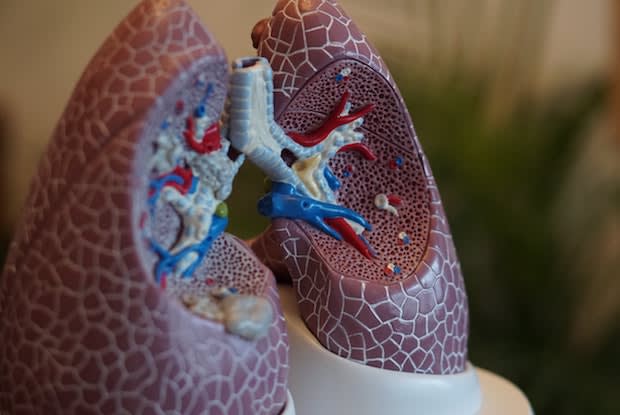Table of contents
I. Overview of chronic respiratory problems
II. Types of chronic respiratory problems
III. Causes of chronic respiratory diseases
Overview of chronic respiratory diseases
Chronic respiratory diseases (CRDs) are long-term or recurring diseases that affect the airways and other parts of the lung. The lungs are complicated organs that expand and relax thousands of times a day to give the body oxygen and get rid of carbon dioxide. Respiratory diseases can result from problems in any part of this system, although they are often caused by problems in your airways.
Common respiratory diseases include asthma, chronic obstructive pulmonary disease (COPD), lung cancer, and sleep apnea. People who suffer from chronic respiratory diseases may have their quality of life negatively affected in several ways. CRDs account for more than 10 percent of productive life lost due to a condition. [1]
Asthma affects around 334 million people worldwide and is the most common chronic disease in childhood and affects 14 percent of children globally. Additionally, COPD is the third leading cause of death worldwide. [1] Both asthma and COPD are incurable. However, both conditions can be treated with medications like Advair Diskus and managed to generally improve sufferer’s quality of life.

Types of Chronic Respiratory Diseases
There are many types of chronic respiratory diseases, with the most two common being asthma and chronic obstructive pulmonary disease (COPD). These are both diseases that cause swelling in your airways, making it more difficult for you to breathe.
a. Asthma
Asthma is a disease that causes your airways to be regularly inflamed and often spasm. Asthma symptoms differ for each person who suffers from it. Common symptoms of asthma may include wheezing and shortness of breath and these may be activated by infections, allergies, or pollution. [2] If you experience any of these symptoms, speak to your doctor because the sooner you begin asthma treatment, the less damage that will be caused to your lungs over time. [3]
Asthma affects up to 334 million people worldwide. [1] In the United States, Asthma affects 25 million people and causes almost 2 million visits to emergency rooms each year.[4] It is currently incurable, although it can be managed through inhalation medications.
b. Chronic obstructive pulmonary disease (COPD)
Chronic obstructive pulmonary disease (COPD) covers a wide range of lung conditions. COPD conditions are categorized by an inability to breathe out normally due to lung inflammation. The inflamed tissue of the lungs can also be destroyed. [5]
COPD affects more than 200 million people in the world, is the third leading cause of death worldwide [1] and the third leading cause of death by disease in the United States. [5] COPD may not always be diagnosed. Approximately 16 million Americans have COPD, although the American Lung Association (ALA) believe it may be as many as 24 million. [6]
Two of the most common types of COPD are emphysema and chronic bronchitis. [7] Both of these conditions disproportionately affect adults over 45. 75 percent of new cases of chronic bronchitis and 90 percent of emphysema cases involve adults over 45.
Common early symptoms of COPD can include shortness of breath and tiring easily. Later on, you may also develop swelling in your legs and feet or a cough which may produce phlegm, mucus or spots of blood.
c. Other chronic respiratory diseases
Respiratory diseases can also be caused by problems with your air sacs (such as most forms of lung cancer), interstitium, blood vessels, pleura or chest wall. [2]
Causes of chronic respiratory diseases
Chronic respiratory diseases may be caused by several factors. It isn’t clear why some people suffer CRDs and others don’t, but it is thought to be a mixture of genetic and environmental factors. [8] The most important risk factors for CRDs are tobacco smoke and air quality. [9]
Smoking: Tobacco smoke can affect your respiratory system through your own smoking and by being exposed to second-hand smoke. Smoking cigarettes may increase your risk of developing many CRDs, including lung cancer, asthma, and COPD. In the USA, current smokers are 25 times more likely to die from lung cancer than those who have never smoked. [1]
Non-smokers should refrain from being exposed to second-hand smoke as much as they can because non-smokers can experience asthma and COPD symptoms as well as cancer. [9]. Globally one billion people are exposed to tobacco smoke and there are over 41,000 deaths in the United States every year due to second-hand smoke. [1]
Air Quality: Air quality is also a major contributor to most respiratory conditions. This can come in the form of indoor air pollution, unhealthy air in the workplace, air pollution caused by traffic and industrial sources, and other causes. [1] Indoor and outdoor air pollution can inflame, irritate, and destroy lung tissue. [10] COPD also occurs in people who have had long-term exposure or contact with harmful pollutants in their workplace.

Medical treatments for chronic respiratory diseases
The severity of your condition impacts the type of medication your doctor will prescribe to you. Most medications for CRDs come in the form of an inhaler. These drugs can come in the form of daily use or a rescue inhaler to relieve sudden asthma or bronchospasm attacks.
Corticosteroid Inhalers: Chronic respiratory diseases are often life-long incurable diseases. Using an inhaled corticosteroid medication such as Flovent HFA, Pulmicort, or Qvar is the most common method of CRD control. [1] [11] Corticosteroid inhalers are long-term control medications and should be used daily, even when you are not showing symptoms. They work by reducing swelling and tightening in your airways. Inhaled corticosteroids usually don’t cause serious side effects but you should rinse your mouth out with water after using them to avoid irritation and infections.
Combination Inhalers: Some inhalers may combine a corticosteroid with a bronchodilator medication. While the corticosteroid reduces swelling, the bronchodilator opens up the air passages in your lungs. Popular combination inhalers include Advair Diskus, Symbicort, Breo, and Dulera. [11]
Rescue Inhalers: You may also be prescribed a quick-relief or ‘rescue’ inhaler such as Ventolin HFA. Rescue inhalers begin working in minutes and can stop asthma or bronchospasm attack in progress. Most people with persistent CRD need long-term control inhaler as well as their quick-relief inhaler.
Other ways to keep your lungs healthy
Canada Meds United is a great way to save up to 90 percent on the cost of your prescription and non-prescription medications and get them delivered directly to your door. Along with taking prescription medications, there are other ways that you can keep your lungs healthy.
Stop smoking: Smoking is the primary cause of serious lung diseases including chronic obstructive pulmonary disease and lung cancer. Even if you have been smoking for many years, stopping smoking now will still help you to reap the benefits of going smoke-free. Two-thirds of cigarette smoke is not inhaled by the smoker but enters the air around. [10] Avoiding second-hand smoke by not allowing it in your home, car or workplace and making sure that your children and family are not exposed to second-hand smoke is a key way of keeping your lungs healthy.

Cleaning your home: It may be more difficult to control air pollution outside, however simple actions inside your home can help to improve your lungs. Keeping your house clean and tidy is a quick and effective way to help those with CRDs. Open your windows regularly, especially when cleaning or doing other household projects. This allows fresh, clean air into your home. You should also control moisture in the air by using exhaust fans in your bathroom and kitchen. It is important to control dust by keeping carpets, bedding, and surfaces clean. [10]
Washing your hands: Along with chronic respiratory diseases, infectious respiratory diseases such as colds and the flu can also affect your lungs. 80 percent of common infectious respiratory diseases are spread by hands. regularly washing your hands with soap and water is a simple way to reduce your risk of sickness. [10]
Natural remedies: Other natural remedies that may ease your symptoms. These can include eating a balanced diet, drinking caffeine, yoga, or aromatherapy.[12]
The content in this article is intended for informational purposes only. This website does not provide medical advice. In all circumstances, you should always seek the advice of your physician and/or other qualified health professionals(s) for drug, medical condition, or treatment advice. The content provided on this website is not a substitute for professional medical advice, diagnosis or treatment.
